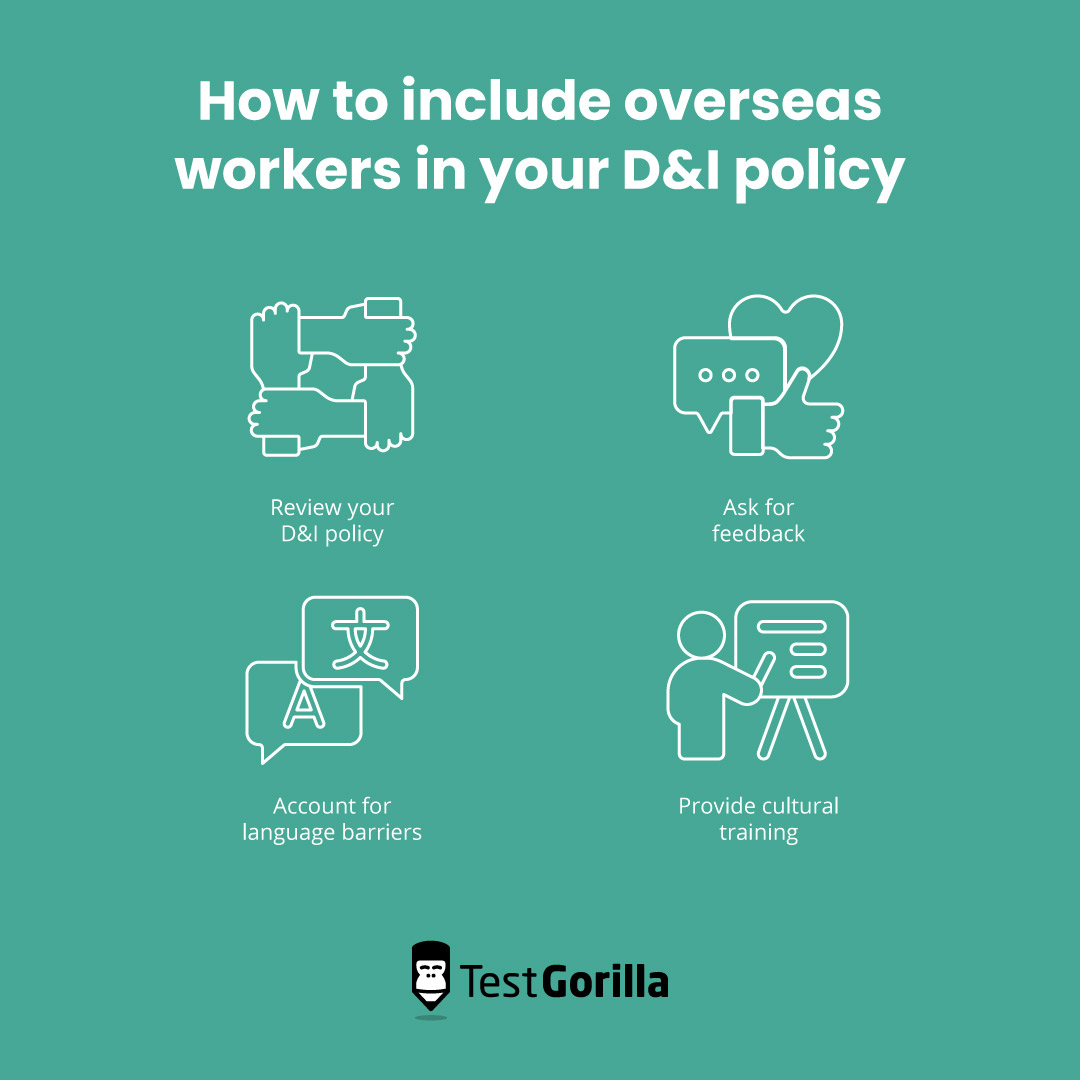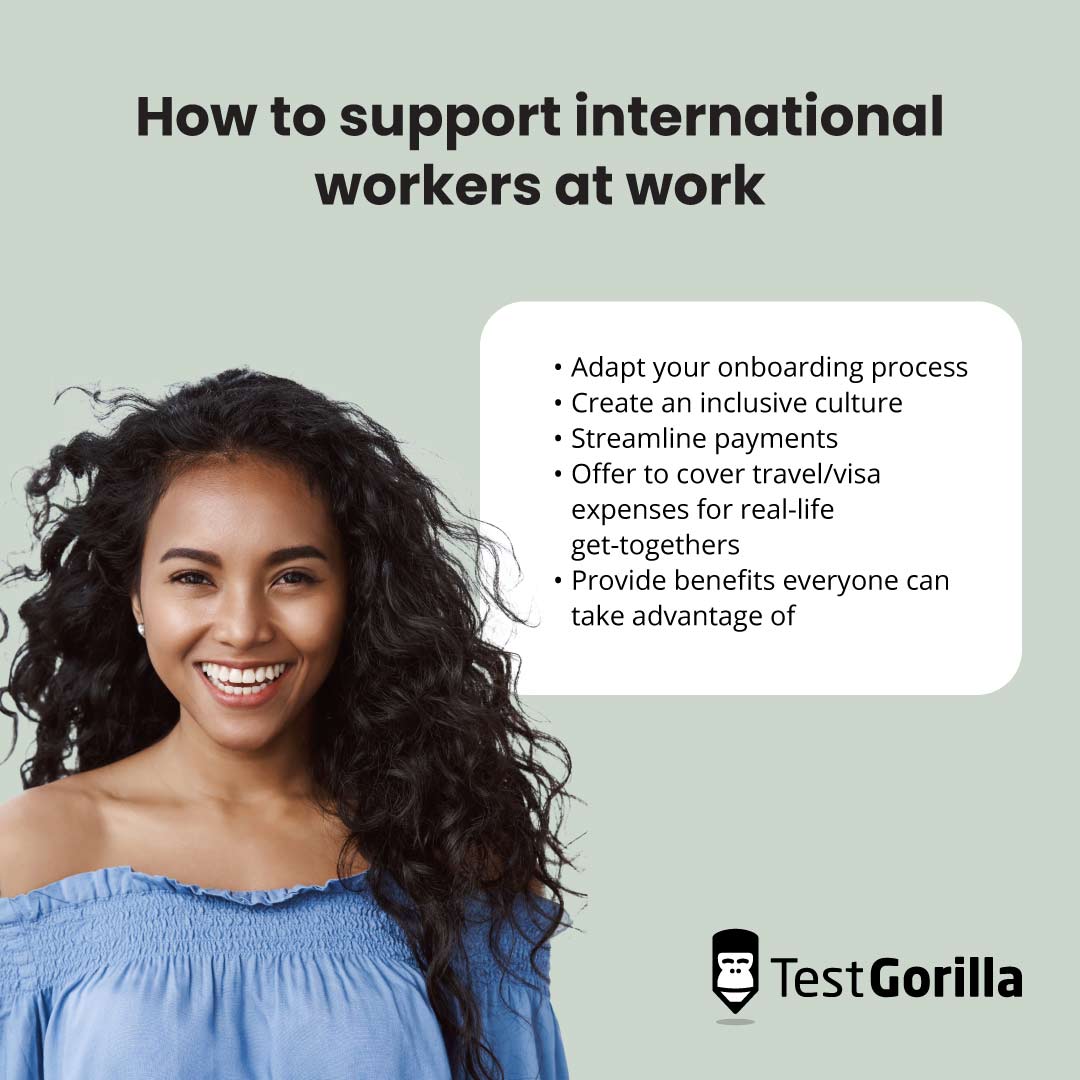The Great Resignation, closely followed by the Great Reshuffle, has created a recruitment crisis around the world with workers quick to switch to something more flexible, more rewarding, or with a greater work-life balance.
In response to this and the shift to remote and hybrid work, employers are looking beyond traditional talent pools to keep their businesses running.
Traditionally, companies would look overseas for low-skilled workers like call center operators, but that’s no longer the case. Instead, they’re as likely to hire their head of finance from not just another city, but the other side of the world.
In this article, we’ll look at how companies hiring employees around the world can get diversity and inclusion (D&I) right so they can support international candidates on their journey through the hiring funnel and into their new roles.
We’ll also examine how skills-based hiring can reduce unconscious bias and help you find the best talent.
Table of contents
A whole world of workers
The Great Reshuffle is far from over, with 52% of Gen Z and millennials considering changing employers in the year ahead.[1]
According to Microsoft, employees have a new “worth it” equation when evaluating a position: 53% of employees are more likely to prioritize their health and well-being over work than they did before the pandemic.[2] While 47% of respondents are more likely to put personal life and family before work.
For today’s companies, it’s harder than ever to win the war for skilled talent. It might be a digital skills gap that makes it harder for modern companies to find candidates with technical skills, or a shift in post-pandemic priorities. Either way, top talent isn’t necessarily around the corner anymore, and you can benefit from looking beyond your borders to find it.
At the same time, remote work has opened the door to people who wouldn’t traditionally be able to access global jobs with higher-paying salaries. Without visa requirements or the need to uproot their families, access to global talent is bridging the gap between in-demand skills and accessible ones.
International recruitment, unconscious bias, and prejudice
Despite the recent explosion of opportunity and the global search for better employment, there are lingering obstacles that can hold minorities back. This affects people of color, women, and candidates from countries that struggle to get working visas for the US or Europe.
We’ve spoken to international candidates from around the world about their experiences with unconscious bias and prejudice in the recruitment process.
Here are some of the main ways they’ve experienced discriminatory behavior within international hiring:
Job descriptions that request ‘native’ English speakers and writers, meaning to exclude native speakers whose national language isn’t English, but are otherwise fluent.
Gendered job descriptions in notoriously male-driven industries, i.e. tech and finance.
Jobs that specify UK/US/Canadian nationality or residency for remote work.
Companies that ask for visa and immigration status during the application process for remote work.
Offering lower wages for overseas workers of the same position (with employers explaining this is due to lower-quality work, according to an anonymous source we spoke with).
Micro/macro aggressions against a candidate or group of people during the interviewing process. For example, one anonymous source told us about her experience looking for a remote writing job in the cryptocurrency space. Although she was an expert in the booming market, a Canadian employer was hesitant to hire her due to negative past experiences with another Indian writer.
Requiring non-White applicants to submit reading and writing comprehension tests or additional work samples on top of their applications.
Now that you know some of the challenges overseas employees can face, let’s jump into how you can better support them in the hiring process.
The best insights on HR and recruitment, delivered to your inbox.
Biweekly updates. No spam. Unsubscribe any time.
Supporting international workers in the hiring process
Most companies nowadays have D&I policies to protect people of color, women, and LGBTQ+ people across an organization. However, there seems to be a lack of policy to protect international employees.[3] This can present some risk to remote talent, especially since remote workers often file as contractors without stable tax forms like a W-2 or 401-K.
To make sure international employees feel supported in the hiring process, you can show them, rather than tell them, what psychological safety in a remote environment looks like. Here’s how:
Include overseas workers in your D&I policy
To attract international employees to your job listings, it’s important to include them in your D&I policy. This can range from inclusive language on the job posting to actual policy reform. To do this:
Review your D&I policy. If it’s not inclusive of all employees, revise it.
Ask for feedback. See how your D&I recruitment process stacks up with your international colleagues. Implement key ideas for improvement, and then ask for more feedback.
Account for language barriers. If your company has multiple branches, nationalities, and spoken languages, make sure you offer translations on important company documents and internal comms.
Provide cultural training. Cultural differences can cause misunderstandings and communication breakdowns, so it’s important to provide cultural training to all workers.
For more insight into diversity and inclusion hiring, check out our D&I hiring guide.
Design a hiring funnel that reduces the chance of unconscious bias
It can be hard to escape unconscious biases during recruitment, which can prevent you from accessing, attracting, and retaining the best talent. That’s why it’s crucial to develop a hiring funnel that eliminates applicant bias for you — and ensures a flawless candidate experience.
Let’s investigate!
Use blind resumes
Make sure identifying information like name, location, race, and age are removed from applications before hiring managers see them. This can help you select the best candidate for the open role, regardless of their background or identity.
Additionally, if you’re asking candidates to do an interview, make sure another hiring manager reviews the resume and any submitted tests and tasks to reduce unconscious bias.
Write inclusive job ads
There are a few ways you can make your job ads more inclusive, for example:
Use inclusive language. Avoid using language that can be exclusive or biased, such as terms that are associated with certain genders, races, or backgrounds. For example, avoid using terms like ‘ninja’ or ‘all-star’ to describe the ideal candidate, as they may be seen as exclusionary. Also, use a job title that doesn’t include gender, race, or other demographic identifiers. For example, instead of using ‘salesman,’ use ‘sales representative’ or ‘sales associate.’
Focus on skills and qualifications. Instead of focusing on specific demographics, emphasize the skills and qualifications needed for the job.
Avoid unnecessary requirements. Don’t list requirements that aren’t necessary for the job. For example, visa or citizen status for remote job postings.
Highlight your commitment to diversity and inclusion. Include a statement in your job ad that highlights your commitment to creating a diverse and inclusive workplace.
Use skills-based hiring
Skills-based hiring is a recruitment approach where you hire candidates based on quantifiable skills, not bias-prone methods like Applicant Tracking Systems or resumes.
With skills-based hiring, you select candidates based on skills assessments — including take-home tasks and skills tests — and referrals before being invited for an interview.
Role-specific tests measure hard and soft skills like customer service skills and skills related to leadership, programming, communication, and much more. On the other hand, tasks or assignments may require candidates to provide a work sample or complete a project at home. This lets you evaluate their capacity to handle situations that are specific to the role.
Ultimately, by only assessing candidates on their skills, you can better eliminate unconscious bias and get the right person for your open role.
After surveying 2,736 employers for our 2022 State of Skills-Based Hiring report, we found that 91% of employers saw an increase in employee diversity after implementing skills-based hiring in their organization. Additionally, once placed in a position that plays to their strengths, candidates are less likely to leave — so you can build a strong, diverse, and dispersed workforce.
Recruit for culture add (not culture fit)
Recruiting for culture add, or a candidate that actively transforms company culture, means you’re not simply looking for someone that will fold neatly into it.
It’s an important distinction for creating a diverse and inclusive workforce because, unlike ‘culture fit,’ it’s not littered by personal preferences, hiring biases, and poor hiring practices. For example, overconfidence or affinity bias during recruitment.
To recruit for culture add, or someone who will evolve company culture instead of stagnating along with it, here’s what you can do:
Know the values of your organization. Identify your company values before searching for them in your candidates. This helps you search for candidates with a difference in ideas, not values.
Evaluate candidates on an objective basis. Use talent assessments like the Culture-add test to determine if a candidate can bring a different perspective to your work environment.
Create a culture committee
A culture committee should be made up of people from across the company, not just leadership, to accurately reflect your company’s culture during the hiring process. You can use a culture committee during the candidate interview process to check for microaggressions against certain groups of candidates, which you might not spot if the interviewer has the same gender and cultural background as the interviewee.
By including employees with different backgrounds during candidate interviews, you can gain valuable feedback on the recruitment process. It also helps you address any perceived issues of hiring bias and reduce micro/macro aggressions during interviews.
Showcase your global employee distribution
If you’re committed to hiring globally, why not showcase it with a global employee distribution map? This pinpoints where your employees work (either on your website or job ad) so candidates can get a visual demonstration of your global team.
It also can create a sense of personal connection to the company by inspiring candidates to be the next pin on the map — and celebrating wherever that might be.
TestGorilla uses a global distribution map so candidates can see where their potential colleagues work: all over the world.
Now that you’ve seen how to support overseas employees in the hiring process, let’s take a look at how to take care of your international workers on the job.
Supporting international workers at work
Remote workers take on more risk than traditional full-time ones and have less of a safety net if they’re laid off. For example, working without the benefits of a severance package, government welfare, or untaxed retirement funds.
Therefore, it’s important to support your international workers and help them feel comfortable, secure, and happy in their place of work. Here are a few ways you can do this:
Adapt your onboarding process
Check your employee onboarding process to ensure it doesn’t have exclusive language, like British or American colloquialisms that other English speakers might not be aware of.
It’s also important to check your onboarding materials for possible biased language, like gender assumptions, ageism, and racial or ethnic prejudice. For example, referring to someone as an ‘old timer’ or asking if someone is an ‘illegal immigrant’ instead of an ‘undocumented’ one.
One way you can do this is to experience it yourself. First, go through your employee onboarding process from start to finish. Then, take it a step further by going through the process with members of your culture committee, and take notes (or collect feedback) on how it made everyone feel.
Create an inclusive culture
Negative experiences at work can drive top talent to look elsewhere. In fact, 90% of remote workers who rate their work culture as poor have thought about quitting.[5]
Once a company gets a reputation for toxic workplace culture, recruiting and retaining talent is a challenge. That’s why it’s important to create a psychologically safe and inclusive one:
Embrace diversity and inclusion by being open to different perspectives and ideas, and encouraging employees to share their experiences and opinions.
Celebrate cultural events and holidays and don’t assume anyone follows or subscribes to a specific belief or holiday.
Play team-building games to encourage open communication and dialogue between employees from different backgrounds.
Address barriers to inclusion that may exist in the remote workplace. For example, difficulties with access to technology, language barriers, and cultural differences.
Offer flexibility and recognize that remote employees may have different schedules, time zones, and work styles.
Streamline payments
Payments for international workers in the EU or US might arrive instantly, but this can take longer for people from different countries with different banks. Consider issuing paychecks early or changing systems to ensure prompt payments for everyone across the board.
To streamline remote payments:
Set up automatic reminders to remind your employees to send their invoices at the same time each month.
Choose a reliable payment system like Revolut that automatically pulls data from your employee invoices and issues payments.
Offer to cover travel/visa expenses for real-life get-togethers
If your company decides to get together in person, consider that ‘easy travel’ might not be accessible to everyone. It’s important to check in with your team and see how you can support them with any paperwork, costs for organizing visas, and finding airport transportation.
Provide benefits everyone can take advantage of
It’s crucial to make sure everyone can enjoy the benefits you offer your remote workers.
For example, if you offer a digital credit card for home office-related expenses, make sure it can be accessed by people no matter where they are in the world.
We spoke to a remote worker based in South Asia who wasn’t able to access the same monthly stipend as the rest of her team of approximately 200 Euros per month. While everyone else could use the money to pay for office supplies or wellness treatments, this employee’s allowance remained untouched because the European payment processor wasn’t accessible in her location. However, because this system worked for the rest of the team, no change was made to better support her needs.
By giving all your employees equal access to benefits, you can show them that they are valued team members and that their specific circumstances matter.
Here are some ideas for perks that everyone can take advantage of:
Health and wellness benefits like a gym membership of their choosing, online exercise classes, and a subscription to an accessible mental health app like Calm.
A fixed remote work stipend that’s added to their paycheck, so you don’t need to rely on third-party tools or digital credit cards.
Unlimited paid time off with a minimum time off requirement. This way, everyone feels compelled to take time when they need it.
Training and development benefits like an online course, training, or certification everyone has access to.
Skills-based hiring: how to do remote recruiting right
More than ever, global employees are becoming aware of what they want out of a job — and quite frankly, their lives. When employees don’t have the right balance, whether that’s an inclusive and diverse workplace or work-life balance, they’re more likely to search for greener pastures.5
To overcome skills shortages at home and win the war for talent, employers are increasingly hiring remote workers from across the world. However, hiring managers should be aware that their recruitment practices aren’t necessarily welcoming and supportive of candidates from outside the US, UK, or Europe.
To recruit and retain an international team, hiring managers can adopt D&I practices — like recruiting for culture add, providing benefits everyone can take advantage of, and using blind resumes — to better accommodate their diverse, overseas candidates.
With a skills-based approach to hiring, you can get the best talent out there while championing their journey through the hiring funnel — and when they start their new roles.
Want to recruit the best remote talent? Skills-based hiring gives you access to skilled applicants — no matter where. Download the State of Skills-based Hiring 2022 report to learn more.
Sources
“The New Graduate: The Career Aspirations of Generation Z.” (2019) Gartner. Retrieved on April 11th, 2023. https://emtemp.gcom.cloud/ngw/globalassets/en/human-resources/documents/trends/the-new-graduate-career-aspirations-gen-z.pdf
“Microsoft announces new research and technology to make hybrid work work.” (2022) Microsoft. Retrieved on April 12, 2023. https://news.microsoft.com/2022/03/16/microsoft-announces-new-research-and-technology-to-make-hybrid-work-work/
“Greater progress on diversity and inclusion essential to rebuild productive and resilient workplaces.” (2022) International Labor Organization. Retrieved on April 26, 2023. https://www.ilo.org/global/about-the-ilo/newsroom/news/WCMS_841085/lang–en/index.htm
“Strengthening Workplace Culture: Global Culture Research Report 2022.” (2022) SHRM. Retrieved on April 11, 2023. https://www.shrm.org/hr-today/trends-and-forecasting/research-and-surveys/Documents/SHRM%202022%20Global%20Culture%20Report.pdf
“Global Workforce of the Future Research” (2023) Adecco Group. Retrieved on April 26, 2023.
You've scrolled this far
Why not try TestGorilla for free, and see what happens when you put skills first.
















